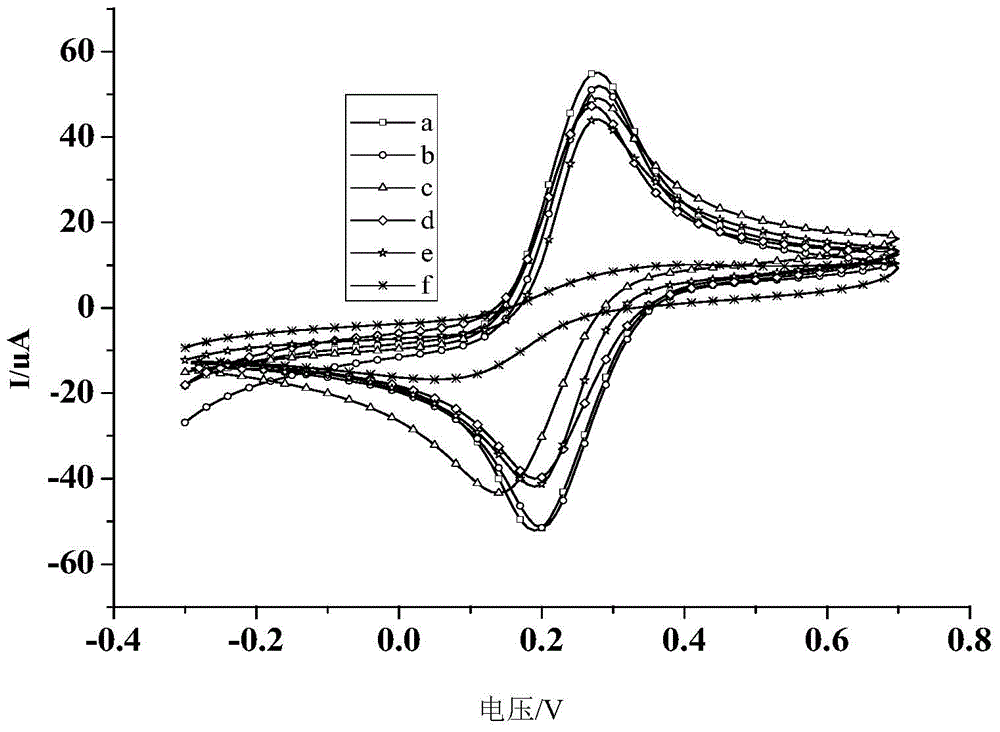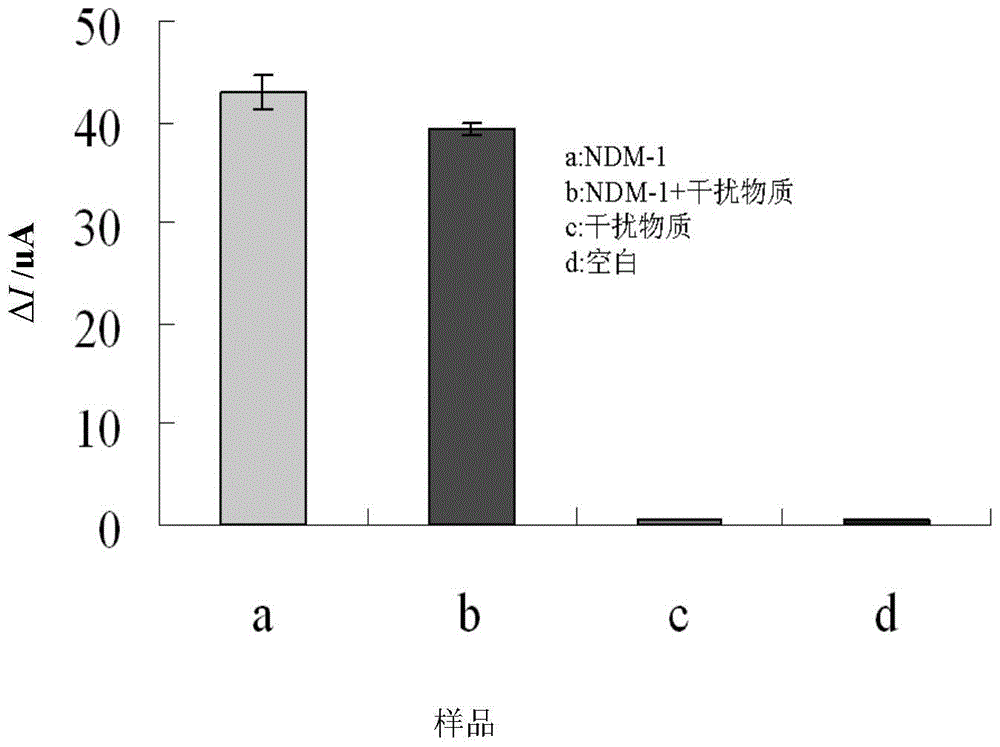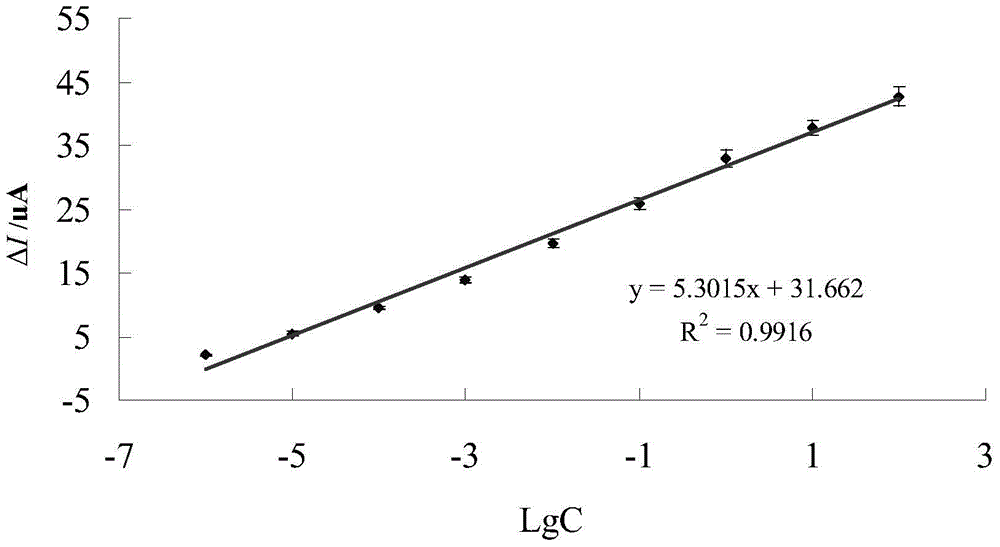Electrode modified based on graphene oxide, gold nanotube and locked nucleic acid probe and its preparation method and application
A technology for locking nucleic acid probes and gold nanotubes, applied in the field of electrode preparation, can solve the problems of DNA probes with low specificity, weak specificity, base mismatch, etc.
- Summary
- Abstract
- Description
- Claims
- Application Information
AI Technical Summary
Problems solved by technology
Method used
Image
Examples
Embodiment 1
[0031] The preparation method based on the electrode modified by graphene oxide, gold nanotube and locked nucleic acid probe comprises the following steps of graphene oxide, gold nanotube and locked nucleic acid probe modified gold electrode and preparation of signal amplification probe:
[0032] (1) Preparation of graphene oxide ZnO sol-gel composite: Weigh 0.001g graphene oxide in a small beaker, add 1mL of ultrapure water, and then place it in an ultrasonic instrument to prepare a graphene oxide suspension, Take 90 μL of graphene oxide suspension, 30 μL of ZnO sol-gel and 60 μL of absolute ethanol and mix well to prepare a graphene oxide ZnO sol-gel mixture, and store it in the dark at 4°C for later use;
[0033] (2) Pretreated electrodes: use 0.3μm and 0.05μm Al for the electrodes 2 o 3 The powder is ground and polished to a mirror surface, rinsed with ultra-pure water after each grinding, and then ultrasonically washed in nitric acid, acetone and ultra-pure water for 5 m...
Embodiment 2
[0036] Embodiment 2, set up electrochemical biosensor
[0037] The electrode modified by graphene oxide, gold nanotube and locked nucleic acid probe is used as the working electrode, the saturated calomel electrode is used as the reference electrode, and the platinum electrode is used as the counter electrode to form an electrochemical biosensor. Connect the assembled electrochemical biosensor to the electrochemical workstation, and in pH7.4 containing 2mmol / L K 3 Fe(CN) 6 / K 4 Fe(CN) 6 Cyclic voltammetry scanning was carried out in PBS with 5mmol KCl, the working potential was -0.3V~0.7V, and the scanning speed was 50mV / s.
[0038] Hybridization reaction: immerse the gold electrode modified by graphene oxide, gold nanotube and locked nucleic acid probe into 150 μl of different concentrations of NDM-1 target sequence solution (10 -6 μg / L, 10 -5 μg / L, 10 -4 μg / L, 10 -3 μg / L, 10 -2 μg / L, 10 -1 μg / L, 1.0μg / L, 10 1 , 10 2 μg / L), and then add the signal amplification pro...
Embodiment 3
[0040] Embodiment 3, step-by-step characterization based on graphene oxide, gold nanotubes and locked nucleic acid probes
[0041] Use cyclic voltammetry to characterize the electrochemical characteristics of the electrode during the modification and detection process. The specific detection method is: immerse the modified electrode in 150 μL of NDM-1 target sequence solution with a concentration of 100 μg / L, and then add lock to the reaction system. Nucleic acid probe solution, hybridized at a constant temperature of 37°C for 45 minutes. During the hybridization process, the sensor used a three-electrode system to measure the current change, and obtained a concentration of 2mmol / L K at pH 7.4 for different electrodes. 3 [Fe(CN) 6 ] / K 4 [Fe(CN) 6 ] and the cyclic voltammetry curve (CV) figure in the PBS solution of 5mmol / l KCl, as figure 1 shown.
[0042] figure 1 Among them, curve a is graphene oxide ZnO sol-gel and gold nanotube modified electrode containing 2mmol / LK at...
PUM
 Login to View More
Login to View More Abstract
Description
Claims
Application Information
 Login to View More
Login to View More - R&D
- Intellectual Property
- Life Sciences
- Materials
- Tech Scout
- Unparalleled Data Quality
- Higher Quality Content
- 60% Fewer Hallucinations
Browse by: Latest US Patents, China's latest patents, Technical Efficacy Thesaurus, Application Domain, Technology Topic, Popular Technical Reports.
© 2025 PatSnap. All rights reserved.Legal|Privacy policy|Modern Slavery Act Transparency Statement|Sitemap|About US| Contact US: help@patsnap.com



